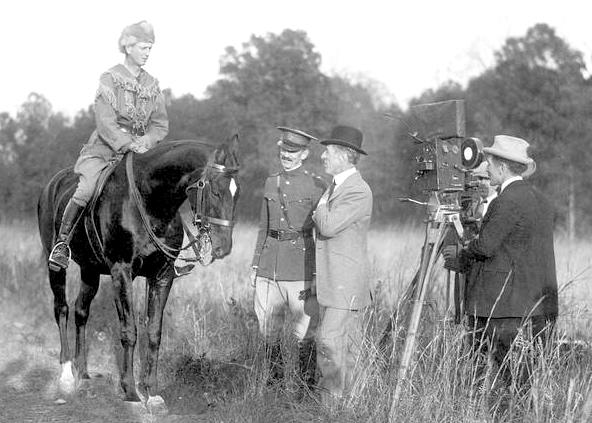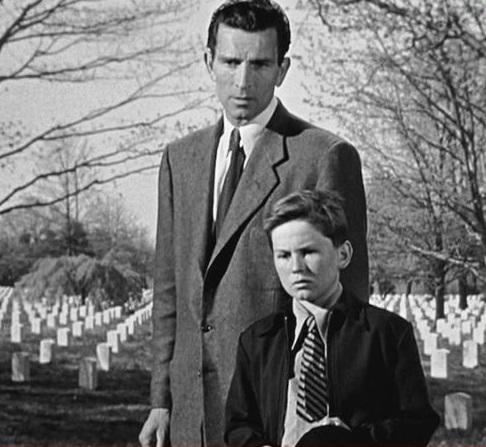The Intersection of Hollywood and Arlington Boulevards

The history and development of motion pictures can be seen through films with scenes shot in Arlington.
From the earliest days of the silent film era, producers and directors have found Arlington County to be a hospitable place for filmmaking. There are three primary reasons: proximity to and spectacular views of our nation's capital, internationally recognized landmarks, and film-friendly military, state, and local governments.
The history and development of motion pictures can be seen through films with scenes shot in Arlington. The county remains a popular location and regularly fields permit requests from production companies of all sorts. The first films were called "actualities," a term that loosely translates into today's documentaries. Beginning with the first commercial exhibition in 1895, producers like Thomas Edison and France's Lumiere Brothers sent cameramen around the globe to capture scenes that middle and working-class families could only dream of visiting.
If a newsworthy event was unfolding, enterprising cameramen, often working on "spec," could be counted on to show up and film history in the making. At least as early as 1897 films shot at Fort Myer depicting cavalry reviews and bareback riding exhibitions were popular entertainments. The earliest surviving film shot in Arlington depicts the Wright Brothers' demonstration of their airplane to the military brass at Fort Myer in 1908. This was a momentous occasion in the careers of Wilbur and Orville Wright because a successful demonstration of their airplane's potential as a military vehicle for reconnaissance or weaponry would ensure their fortunes. No less than a $25,000 award was at stake. Wilbur was in France so Orville conducted several successful demonstrations in early September.
These were filmed and the resulting newsreels were distributed all over North America. However, tragedy struck on Sept. 17, when Orville took 175 lb. Lt. Thomas E. Selfridge aloft and the plane apparently buckled under the added weight. The resulting crash severely injured Orville and killed Lt. Selfridge. This was not captured on film, but the crowd of over 2,000 included photojournalists who captured the awful aftermath of the crash and spread the news throughout the world. Ironically, if the fatal crash had been filmed, it would have helped the Army and Orville to piece together the exact cause of the accident since witnesses reported seeing a part fly off the plane just before it began its descent.
In 1924, D.W. Griffith's reputation as a director was beginning to wane. Several years of programmers and big-budget flops were threatening the great director's independence and he needed a hit on the order of his epic Birth of a Nation. The 1915 film had told the story of the Civil War from the perspective of the South and was an international hit that solidified his reputation as the world's first great producer/director. Griffith hit on the idea of telling the story of the Revolutionary War filmed as much as possible in the actual locations. His film was to be called America and it was destined to be the last silent historical epic the director would ever make. As usual, Griffith told his story through fictional characters as they witnessed and participated in real historic events.
His small company filmed at historic locations in New England, New York, Pennsylvania and as far south as Virginia, where he filmed members of Fort Myer's 3rd Cavalry dressed in buckskin as Morgan's Raiders. Perhaps due to the weakness of the fictional dramas depicted in the film, America wasn't the hit that Griffith had hoped for. The fiercely independent producer-director was forced to liquidate his studio at Mamaroneck, NY and become an employee of Paramount Pictures.
After Warner Brothers' The Jazz Singer ushered in the sound era in 1927, location filming became more difficult. Bulky sound equipment was difficult to move and diminished Depression-era budgets kept all but the largest productions studio-bound in Hollywood.
One notable exception was a 1934 RKO military comic melodrama, Keep 'Em Rolling, starring Walter Huston as veteran Sgt. Benjamin E. 'Benny' Walsh, whose two loves are the U.S. Army Cavalry and his horse, Rodney. The story concerns the battles that Sgt. Walsh and Rodney face when a new military efficiency expert decides they should both be put out to pasture. Location filming and the participation of the 16th Field Artillery added authenticity to the story.
A generation later another military drama was filmed on location at Fort Myer, Gardens of Stone (1987), featuring James Caan as yet another grizzled veteran, Sergeant Clell Hazard. This Francis Ford Coppola-directed story is set against the Vietnam War years as Sgt. Hazard vainly tries to help young soldiers destined to be shipped off to war. The nation's most hallowed ground made one of its earliest appearances in The Day the Earth Stood Still (1951). Fittingly, the cemetery was used as a backdrop for a very effective anti-war message. An alien from another world, Klaatu, lands on Earth to warn humans that unless warfare is eliminated, Earth will be attacked as a threat to the sanctity of life in the rest of the universe. After being wounded by soldiers from Fort Myer (though the base was apparently filmed in California), Klaatu decides to visit Earth in human form. He befriends a family and is taken to Arlington National Cemetery by their young son Bobby. It is here that Klaatu learns of the awful toll that war has taken on this planet. Because location filming did not extend to bringing the actors East, Michael Rennie and Billy Gray filmed their scene against a rear-projected Arlington National Cemetery filmed by the same second-unit crew that filmed the opening scenes of a spaceship landing on the National Mall.
1 Internet Movie Database, www. imdb.com © 1990-20 10. 2 Fred Howard, Wilbur and Orville: A Biography of the Wright Brothers (New York: Alfred A. Knopf,1987), pp. 262-281. 3 Richard Schickel, D. W Griffith: An American Life (New York: Simon and Schuster, 1984), pp. 486-495. 4 www. imdb.com.
; Ibid.
6 DVD viewed by author, The Day the Earth Stood Still (1951: Twentieth Century Fox).
Images

